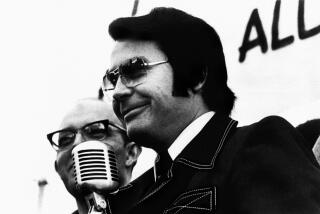Cult May Have Produced Drug, Sold It to Gang
- Share via
TOKYO — Poison gas may not have been the only thing Aum Supreme Truth allegedly brewed in its laboratories, Japanese police say: Officials reportedly plan to pursue charges against the cult for transforming its Mt. Fuji compound into a methamphetamine production center and selling the stimulant to this nation’s largest organized crime group for distribution in western Japan.
In extensive raids over two months, police have seized equipment and chemicals, such as hydrochloric acid, that can be used to make the stimulant. They have also found traces of the drug in soil samples around the cult’s Mt. Fuji complex and in the hair of some followers.
Police also are said to have seized notes on how to make the drug--commonly called ice or speed in the United States--in the handwriting of Masami Tsuchiya, head of the sect’s chemical team.
Cult leader Shoko Asahara, arrested Tuesday on suspicion of murder in connection with the poison gas attack on Tokyo subways March 20, reportedly administered stimulants to at least 700 followers in initiation rituals. Other members are believed to have used drugs to heighten meditative experiences, sometimes through drug-laced cookies, or to have been forcibly injected with them.
But authorities here believe the group turned to commercial sales beginning last year to feed the guru’s reportedly growing obsession with money. “They had the know-how and chemicals to do it,” said one narcotics specialist here.
The sect also had the market: Despite its image as a drug-free nation, Japan is known as the “methamphetamine capital of the world,” with an estimated 500,000 abusers who include overworked businessmen, cramming students and bored homemakers.
The trade is so lucrative that it accounts for an estimated 43% of the illicit income of the yakuza --Japan’s organized crime syndicates--bringing in $3.38 billion annually, the National Police Agency has reported.
“The treadmill is very fast in Japan, and people use this [stimulants] to stay on,” said David Kaplan, author of “Yakuza,” a groundbreaking study of organized crime in Japan.
Some here speculate that the nasty world of narcotics and gangsters provided the murky backdrop for the fatal stabbing last month of Hideo Murai, the cult’s chemical chief, and the disappearance of a lawyer and his family in 1989.
Two men with ties to organized crime have been arrested on suspicion of killing Murai. And in 1990, the Shukan Post magazine raised questions about the cult’s connection to “white powder” and the lawyer’s disappearance.
Supreme Truth has denied allegations that it has manufactured drugs and is suing the magazine for libel.
The sect’s huge stockpiles of dangerous substances are also raising questions about whether Japanese authorities violated international narcotics treaties through lax monitoring of chemical purchases.
In 1991, Japan signed the 1988 Vienna Convention on illicit drug trafficking. It requires, among other things, strict record-keeping and background checks into buyers of restricted chemicals.
Sources here question whether Japanese firms selling such chemicals to sect front companies bothered to make background checks--and whether government agents monitored the transactions, as required by the U.N. pact.
In any case, if the sect did establish a clandestine drug factory, it would have been the first successful domestic production center in three decades. Although stimulants once were legal in Japan--the military fed them to kamikaze pilots and wartime workers--authorities shut the factories down in the 1960s, driving production to South Korea and Taiwan.
The Sankei Shimbun, a national newspaper, reported this week that members of the Sumiyoshi and Inagawa crime syndicates in Tokyo were approached by a Supreme Truth member last fall about buying amphetamines. But both groups rejected the offer because of the drugs’ poor quality--and qualms about getting involved with the controversial sect--the newspaper reported.
The cult reportedly improved the quality and struck a deal with the Yamaguchi-gumi, Japan’s largest crime syndicate, which controls the western Japan region, including Kobe, Osaka and Kyoto.
Police suspect the cult destroyed its amphetamine stockpiles and dismantled its production facilities before the massive March 22 raid on its Mt. Fuji compound.
Authorities reportedly were planning to raid the cult compound just before the Tokyo subway attack occurred; some here speculate that the sect made a preemptive strike to buy time to destroy the drugs and conceal evidence.
Chiaki Kitada of The Times’ Tokyo Bureau and Times special correspondent Thomas Caldwell contributed to this report.
More to Read
Sign up for Essential California
The most important California stories and recommendations in your inbox every morning.
You may occasionally receive promotional content from the Los Angeles Times.













